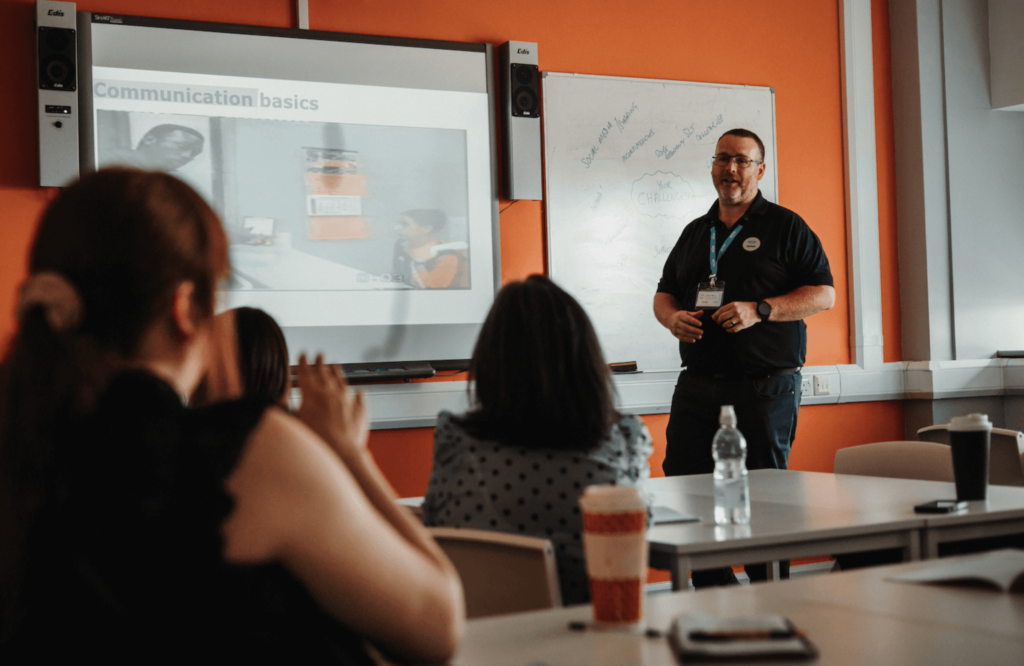How we use NLP techniques in our training courses

By Sam Cherubin – IKON Trainer
Neuro-linguistic programming studies the ways our thoughts affect our behaviour. It looks at how our brains interpret the signals they receive and how these interpretations affect our actions. It does this through language – the linguistic part of neuro-linguistic programming techniques.
By examining how our brains process information, NLP techniques help us look at our thoughts, feelings and emotions as things we can control rather than things that passively happen to us.
NLP at its core: We can change the way we think, feel and behave by changing our focus – because where focus goes, energy flows. While NLP was created by Richard Bandler and John Grinder in the 1970s, it has been expanded upon by numerous researchers and authors.
NLP techniques
NLP techniques are action oriented, rather than focusing on the why, as you might do in therapy, NLP focuses on the how.
How can you react differently to your thoughts and emotions? How can you adapt your communication style to the situation? How can you change your mindset so that life is happening for you, not to you?
Mirroring
According to the 7-38-55 Rule, just 7% of your message is communicated through words. Your tone of voice contributes 38%, but your body language communicates 55% of your message.
Mirroring is an NLP technique that leverages body language to make instant connections and build rapport with anyone. When you’re talking to someone, mirror your body language to theirs. If they are high energy, match that energy level. If their body language is relaxed, reflect that. You can even change the words you use to match their vocabulary. The other person will automatically find you more trustworthy – because you are just like them.
When delivering Conflict Resolution Training, I am constantly looking at the audience’s non-verbal signals, some of our delegates are nervous, so one of the things I say is, ‘there is no role play here. If you observe them, then see a shift in their body language, allowing me in.
The personal touch is taking note of their names; everyone wants to feel important. Once the first exercise has been completed, I make mental notes of individuals who are smiling, and they will be the ones initially I will direct a question to them.
The correct language is essential, using the same terminology as our delegates, and matching their vocabulary, which creates rapport.
Metaphor
Using an NLP Metaphor will enable you to make suggestions to an individual at a deeper level, which will be received by the unconscious mind and translated into actions to improve their circumstances.
A great NLP Metaphor will be structured to address a specific challenge that individuals may face and include the challenge, the action and the resolution.
When using an NLP Metaphor, you can communicate vast amounts of information in a tiny package that is more interesting and meaningful for the unconscious mind. Using a metaphor ignites curiosity and removes the likelihood of important information being deleted or distorted.
Metaphors are widely used in successful training programmes and are popular during hypnosis.
Aside from these fundamental applications, metaphors are ideal for passing important messages during communication.
When communicating a message to be remembered and understood at a deeper level, you can consider how to explain through a metaphor which will deliver more impact and meaning from your communication.
For example, a metaphor for NLP could be:
The mind is like maintaining a garden, clearing old weeds, and planting the right seeds. However, if this maintenance is not continued, weeds will overrun the garden, and seeds will not grow
Ref: https://nlptrainingworld.com/metaphors-in-nlp-what-is-and-how-it-helps/
My voice will go with you. The teaching tales of Milton H. Erickson

NLP used in an IKON Training Conflict Resolution course
During an IKON Training Conflict Resolution skills training course, we use methods to diffuse a conflict situation and explore understanding and interpreting different forms of communication, which is a crucial skill we develop throughout our lives.
It helps us to manage situations we find ourselves in, and when conflict arises.
It’s equally important to understand that you will also display body language for the other party to read. The combination of verbal communication and body language will contribute to how the interaction develops.
You may see greater and more noticeable changes to an individual’s body language, for instance, as tension builds. However, by being aware of these clues, you can predict the likely outcomes and increase your chance of diffusing the situation.
For more information:
NHS Conflict Resolution Training course
Education & Further Learning Conflict Resolution Course
Facilities, Retail & Leisure Conflict Resolution Course
Health & Social Care Conflict Resolution Course
Local Authority & Housing Conflict Resolution Training Course
Transport Conflict Management Training Course
Click the button below to make an enquiry about our training.
Make an enquiry
Written by Sam Cherubin – IKON Communications Trainer
A fun and passionate trainer who currently delivers our communication-based sessions, including Conflict Resolution, Lone Working and Personal Safety. Sam coaches’ individuals and teams to help them gain awareness and techniques to manage and resolve unwanted conflict within challenging situations.
Sam is committed to empowering learning and being creative, resilient, determined, clear thinking and resourceful. Sam uses a blend of Emotional Intelligence, Neuro-Linguistic Programming and Psychodrama to enable individuals to find and develop their own critical thinking abilities to generate ideas to prevent conflict and solve existing challenges.
Sam uses his creative mind to develop and design sessions to provide tailored sessions to each group and individual. He models the behaviour he expects during his courses, and his calm, professional and relaxed style engages delegates and all that communicate with him.

